You’ve just wrapped up a call with a prospective consulting client. They’re interested in working with you. Congratulations! If you’ve found your way to this blog post, it’s safe to assume you now need to develop a consulting proposal for this client — and you need help doing so. That’s why I’m here.

In this post, I’ll explain what a consulting proposal is, and how to write one that your prospective clients can’t resist.
Table of Contents
- What is a consulting proposal?
- How to Write a Consulting Proposal
- Parts of a Consulting Proposal
- Consulting Proposal Template for Sales
- Consulting Proposal Template for Marketing
- Sample Consulting Proposal
- Consulting Proposal Tools
What is a consulting proposal?
A consulting proposal is a document that outlines the nature, scope, and timeline of a specific consulting project. Like a salesperson’s pitch to a prospect, a consulting proposal highlights the problem your prospective client is experiencing and positions you, the consultant, as the solution.
Many prospective clients request proposals before officially signing on the dotted line. Why? In short, a consulting proposal outlines your working relationship so both parties can stay aligned and understand the other’s expectations. Proposals aren’t paper formalities — they signify the start of an important client-consultant relationship.
This document will effectively take your conversations with the prospect into an active working relationship. That’s why it’s important to write a good proposal.
A good consulting proposal must have the following information:
- A summary of the problems or challenges that your prospect is facing.
- A detailed account of how you’ll solve those problems.
- A list of the results you’ll seek to achieve for their business.
It also includes contractual information such as fees and terms.
.png)
8 Free Consulting Templates
Access 8 templates for consultants in The Complete Consultant's Success Kit.
- Management Consulting Plan Template
- Business Plan Template
- Sales Plan Template
- And More!
Before You Create a Consulting Proposal
Writing a consulting proposal will require a bit of pre-work. You’ll want to get to know your client’s needs and goals.
1. Chat with your client in person or over the phone.
You can’t write an effective consulting proposal without chatting with your prospective client first. Do your best to set up a phone call for this conversation; if you can, meet in person. An email will suffice for getting to know your client and their consulting needs, but letting them see your face and/or hear your voice will help you build trust with them.
2. Understand their challenges and needs.
The better you understand your prospective client’s challenges and pain points, the more impactful your proposal can be.
While a consulting proposal template can help get the job done, the details in your proposals should not be one-size-fits-all; they should be tailored to each client and their needs. Don’t hesitate to follow up with additional phone calls or meetings to better understand your client and what they need from you.
3. Highlight your value proposition.
Hiring a consultant is not a cheap investment, and you want your client to understand that they’re investing in you because you’ll deliver results. You don’t necessarily need to include a section titled “Value Proposition,” either.
Instead, get specific on how you’ll deliver. For example, you could mention how you’ll be increasing X metric, reducing Y negative outcome, or driving Z results for their business.
4. Ask about the details.
A successful proposal reflects the project scope and details to keep both parties aligned. Don’t forget to ask about your client’s ideal timeline, budget, expectations, and outcomes. These details are important for selling a prospective client on your services as well as giving your client a better understanding of how exactly you two will work together.
Knowing how to write a clear, concise consulting proposal can make or break your ability to convert prospective clients. Let’s review how to put together a winning proposal.
Consulting Scope Template
In consulting, a scope of work document ensures that the consultant and client are on the same page from the start regarding the precise work to be completed, by when, and for what investment.
Here’s what I typically see a scope of work document contain:
- Client Details
- Consultant Details
- Project Summary
- Milestones, Tasks, Process, and Timeline
- Project Exclusions
- Investment and Payment Terms
- Communications, Reporting, and Approval Details
- Other Terms
- Signature
- Next Steps
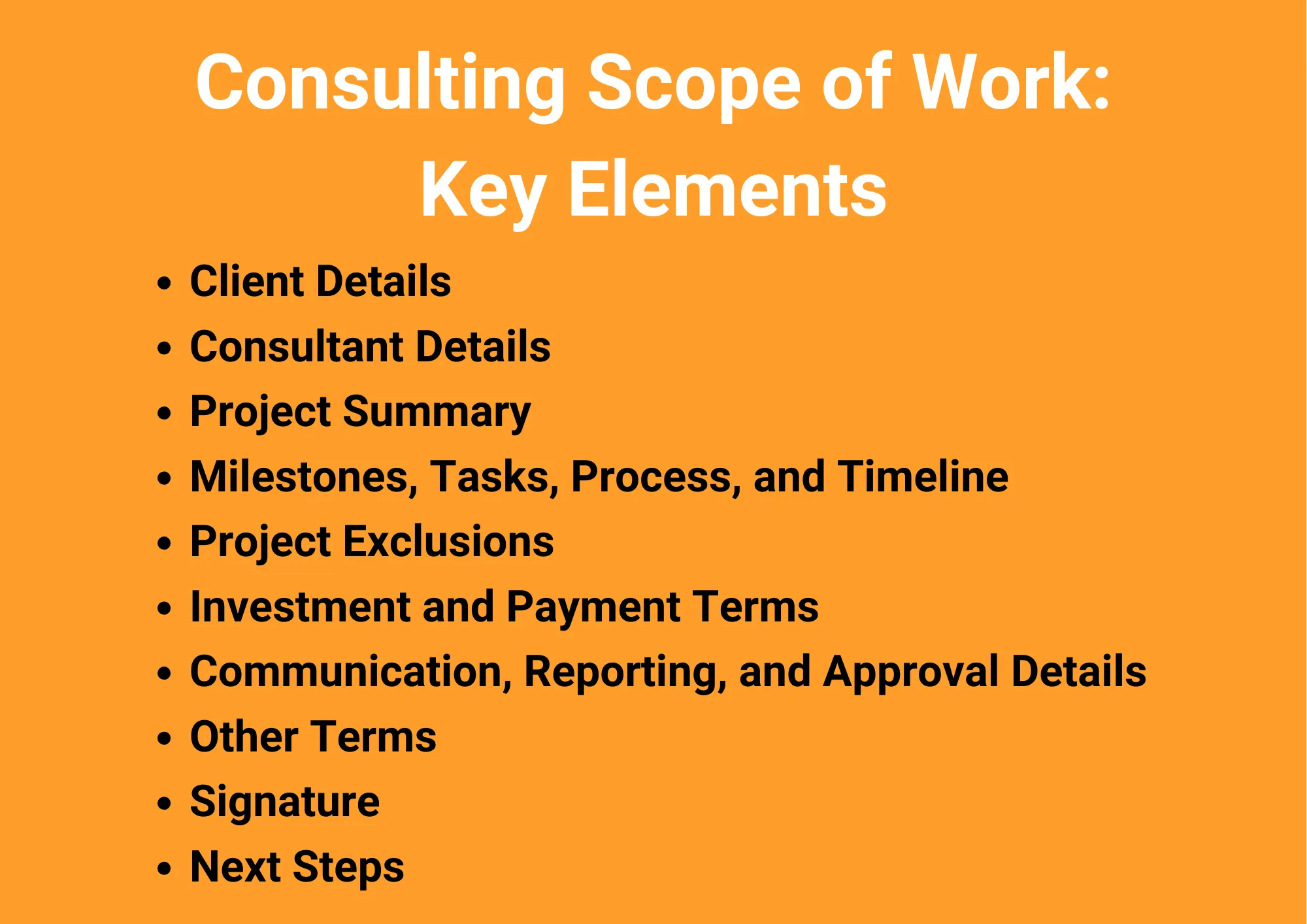
Specificity is key here — unless you clearly outline what you’ll be doing for your client, you may experience scope creep. This can result in monetary loss, strained relationships, and delay in deadlines. At the end? Both parties are unhappy.
To prevent this, it’s vital to have a well-written scope of work document. As Drew McLellan advises, “set limits, set boundaries, and be very specific. Good scope documents include assumptions about both the project and the processes."
Here’s a consulting scope of work template that you can draw inspiration from.
Scope of Work
Client Details
Company Name:
Address:
Company Representative:
Designation:
Email:
Alternate Company Representative (and Contact Details):
Consultant Details
Company Name:
Address:
Consulting Representative:
Designation:
Email:
Project Summary
This project will entail (enter details here in two to three paragraphs).
|
General Details of the Engagement |
|
|
Project Title |
Enter title here. |
|
Project ID |
Enter project ID here. |
|
Project Timeline |
mm/dd/yy - mm/dd/yy |
|
Tasks to be Completed |
Outlined below. |
|
Delivery Format |
Outline how the work will be delivered — such as a presentation, document, website, physical products, or a combination. |
|
Investment |
Outline how the fee structure is determined or add a dollar amount. |
|
Payment Terms |
Summarize key payment terms here and mention that it's covered in detail below. |
Milestones, Tasks, Process, and Timeline
Here’s an overview of the project’s tasks along with the corresponding deadlines:
|
Key Milestones |
Task Number |
Task |
Dependencies (if any) |
Person In-Charge |
Estimated Deadline |
|
Milestone 1 |
|||||
|
Milestone 2 |
|||||
|
Milestone 3 |
|||||
Project Exclusions
The scope of work defines the parameters of the project. Any tasks or services not explicitly specified within this document are considered outside the scope of the project.
Investment and Payment Terms
In consideration of the milestones described above, (Client Company) shall pay (Consulting Company) the following fee structure for the project:
|
Milestone |
Price |
|
Estimated Total |
$00.00 |
Sample Invoice (Attach a sample invoice template for reference)
The payment terms are as follows:
- $X will be paid within (insert number of days) days after signing of this scope of work as an initial deposit.
- Invoices will be submitted every (insert frequency) which will include the price for completed milestones.
- Payment should be made within X days of the invoice receipt.
- Late payment will result in a fee of $X per day.
- List other payment terms.
Communication, Reporting, and Approval
General Contact Details
Client Company
- Primary Contact Person for the Project:
- Contact Information:
Consulting Company
- Primary Contact Person for the Project:
- Contact Information:
Communication Channels
This subsection outlines the communication guidelines for this project, which will take place via:
- Communication channel one
- (Add general guidelines)
- (Add availability/timing/frequency details)
- Communication channel two
- (Add general guidelines)
- (Add availability/timing/frequency details)
- Communication channel three
- (Add general guidelines)
- (Add availability/timing/frequency details)
Reporting
Periodic updates regarding the project progress will be given via:
- Reporting option one
- What it Includes:
- Frequency:
- Reporting option two
- What it Includes:
- Frequency:
Approval
The guidelines for milestone/task approval and final sign-off for the project are as follows:
- (List guidelines here)
Other Terms
- (List and explain other important terms and conditions)
Each party acknowledges that it has read this scope of work, understands it, and agrees to the terms and conditions.
Client Representative (On Behalf of ‘Client Company’):
Designation:
Client Company:
Signature:
Date:
Consulting Representative (On Behalf of ‘Consulting Company’):
Designation:
Consulting Company:
Signature:
Date:
Next Steps
Please read, approve, and sign this document by (insert date here). Once the scope of work is accepted, (Consulting Company Name) shall get in touch within two business days to set up an introductory call for the project.
Note: This template doesn’t constitute legal advice and is for general information purposes only. Before entering into a legal agreement, ask a lawyer to review your scope of work document prior to sending it to a client. This will help prevent issues from arising down the line.
How to Write a Consulting Proposal
- Write an executive summary.
- Briefly describe why you’re the best for the job.
- Specify what the client can expect from the project.
- Establish what your deliverables will be.
- Confirm and outline the costs.
- Specify any other contract terms and conditions.
- Keep the proposal concise.
- Ask for feedback
1. Write an executive summary.
Get started by writing an executive summary or introduction (also called a project summary). This section will include your client’s challenges or obstacles and how you intend to solve them. Simply put, this section summarizes the entire project.
2. Briefly describe why you’re the best for the job.
There’s a good chance your client may be receiving proposals from other companies. You’ll need to show them that you’re the right person for the job and assure them they’re in great hands. Briefly describe how your experience will help the client achieve their goals.
While it may be tempting to hone in on your qualifications and experience, your consulting proposal should focus on what your client will get from working with you. You can add this information as a short (1-2 sentences) paragraph in your introduction.
3. Specify what the client can expect from the project.
Be as specific as possible about the value and outcomes your client can expect. For example, if your main objective is to increase traffic, say that and outline how. This will help you draft your project scope.
Avoid buzzwords and generic jargon. In fact, do your best to use the same words they did in your meetings — this will resonate with them and show you were listening.
4. Establish what your deliverables will be.
Go back to your client conversation notes. Do they need a new marketing strategy, a new website, or advertising plan? What tangible products will they have once the project is completed? These will be your “deliverables” and you’ll want to include them in your proposal so the client knows exactly what they are getting out of the project. I’ll describe deliverables in more detail in the next section.
5. Confirm and outline the costs.
You’ll want to be up front with the client about how much the project will cost. Be clear about your fees and what they include. If you require specific payment structures like a deposit or installments on certain dates, explicitly explain them in this section of your proposal.
6. Specify any other contract terms and conditions.
This section will specify exactly what terms and conditions the client is agreeing to should they decide to proceed. In addition to rates, this can include a timeframe for the project (start and end date), payment types accepted or any other terms you require.
7. Keep the proposal concise.
When it comes to consulting proposals, quality matters much more than quantity. Keep your proposal as brief as possible to accurately describe the project scope and expectations. Don’t give your client a reason to stop reading your proposal and potentially view another consultant’s — instead, keep your proposal concise and engaging.
8. Ask for feedback.
A consulting proposal is a two-way document, meaning both parties should have a say in the content it includes. As you develop your proposal, clarify any questions or concerns you have with your prospective client. When finished, send it to your client for review and feedback.
Consider building your proposal in Google Docs or a similar word processor in which your client can collaborate and leave comments or suggestions.
Now that I’ve covered how to write a consulting proposal more broadly, let’s break it down into parts.
Parts of a Consulting Proposal
The most effective consulting proposals follow an engaging and logical structure. In this section, I’ll discuss the anatomy of a well-written consulting proposal.
1. Salutation
Begin your document by greeting your client.
A personalized greeting sets apart your consulting proposals from a generic proposal. When you treat your proposal as a personal letter, prospective clients are more likely to trust you and want to build a relationship with you. Use the client’s formal name (e.g., “Mr.,” “Mrs.,” or “Dr.”) unless you’re on a first-name basis.
2. Introduction
In this section, write three to four sentences describing the nature of the project and the issues you want to solve.
Consider this section the introduction, or hook, of your proposal. Summarize the challenges your prospective client is facing and what value you can provide through your consulting services. In this section, you should also thank your client for considering you and give them a brief overview of what they can expect from the rest of the proposal.
You can also include one to two sentences introducing yourself and your business. While the proposal shouldn’t be focused on your work as a consultant, it never hurts to include a short section in which you explain why the client should choose you. Even if you pitched yourself during your initial prospective call, you can reiterate your key strengths and qualifications here.
3. Project Scope
Next, add three to five bullet points giving insight into the exact action items (or tasks) you’ll undertake to achieve the desired result.
This section is all about what you’ll be doing to carry out the project you outlined above. For example, if you’re being hired to review and analyze a client’s marketing strategies, this section would outline how long your phone calls or office visits will be, how many calls or visits you commit to each week, the length of each visit, etc. You can never be too detailed in the project scope section; it’ll only save you and your client a headache later.
4. Objectives
In this section, you’ll want to list out three to five objectives for the project.
Now that you’ve covered both the purpose and scope of the project, it’s time to convince the client of the project’s value. What sort of results do you want your client to see after they’re done working with you?
Unlike the deliverables section below, which focuses on the actual “final products” you’ll be delivering, the objectives section focuses on the end result after those products are delivered. It’s important to put this as early as possible in your document so that your client is convinced they’re making a good investment.
5. Deliverables
Next, list out the concrete deliverable(s) the client will have once they’re finished working with you. Will it be a revamped website? A redesigned collection of brochures?
This section outlines the tangible, identifiable end “products” you will be providing your client as a result of the project. If the project scope describes “how,” the deliverables are the “what.”
Following the example above, while your project scope would be reviewing and analyzing marketing strategies, your deliverables may be a detailed analysis document, a presentation of proposed changes, or even a brand-new marketing plan (the specific details will vary depending on your client and their preferences and needs).
6. Timeline
In this section, give a timeline for each specific action item you listed in the “Scope” section.
This section is incredibly important for setting expectations and creating boundaries with clients. If the project scope describes “how” and the deliverables outline the “what,” can you guess what the timeline section is? Ding, ding — it’s the “when.”
The timeline part of the proposal should outline specific project dates and deadlines for different parts of your project. Whether you’re making office visits, creating documents, or simply sending follow-up emails, try to detail every possible date in your proposal. At the very least, make sure you include the project start, final project deadlines, and any milestones in between.
7. Investment
Next, list out your consulting fees and what they include, as well as how and when you prefer to get paid.
If you recommend using a certain payment portal, include that information here. Similarly, if you require a down payment or staggered fee structure, don’t forget that information, too.
Here are some other tips to consider when creating this section of your proposal.
8. Signature
In this section, you’ll immediately ask for a signature from your prospective client. Include space for them to write the day’s date, their name, and their signature.
You’ll want to include this straight in the proposal, even if they’re still in the consideration stage, so that it’s easier to get approval. If you add the additional step of having to send a “finalized contract,” you risk unnecessarily elongating the process.
9. Next Steps
Last, include a strong call-to-action in your proposal. Leave your email for them to contact you as well. Give clear instructions in this final section so clients know how to move forward.
While each proposal should be tailored to each prospective client, it can be tedious to write out the entire document every time. This is where a consulting proposal template can come in handy.
Below you’ll find two consulting proposal templates: one for sales and one for marketing.
Consulting Proposal Template for Sales
You can use this free consulting proposal template in Word or PDF format. The sections match up with what I covered above, but are worded a little differently to better align with sales.
Pro tip: If you use a template, don’t forget to double-check that all client-specific details are updated and correct.
Featured Resource: Free Consulting Proposal Template
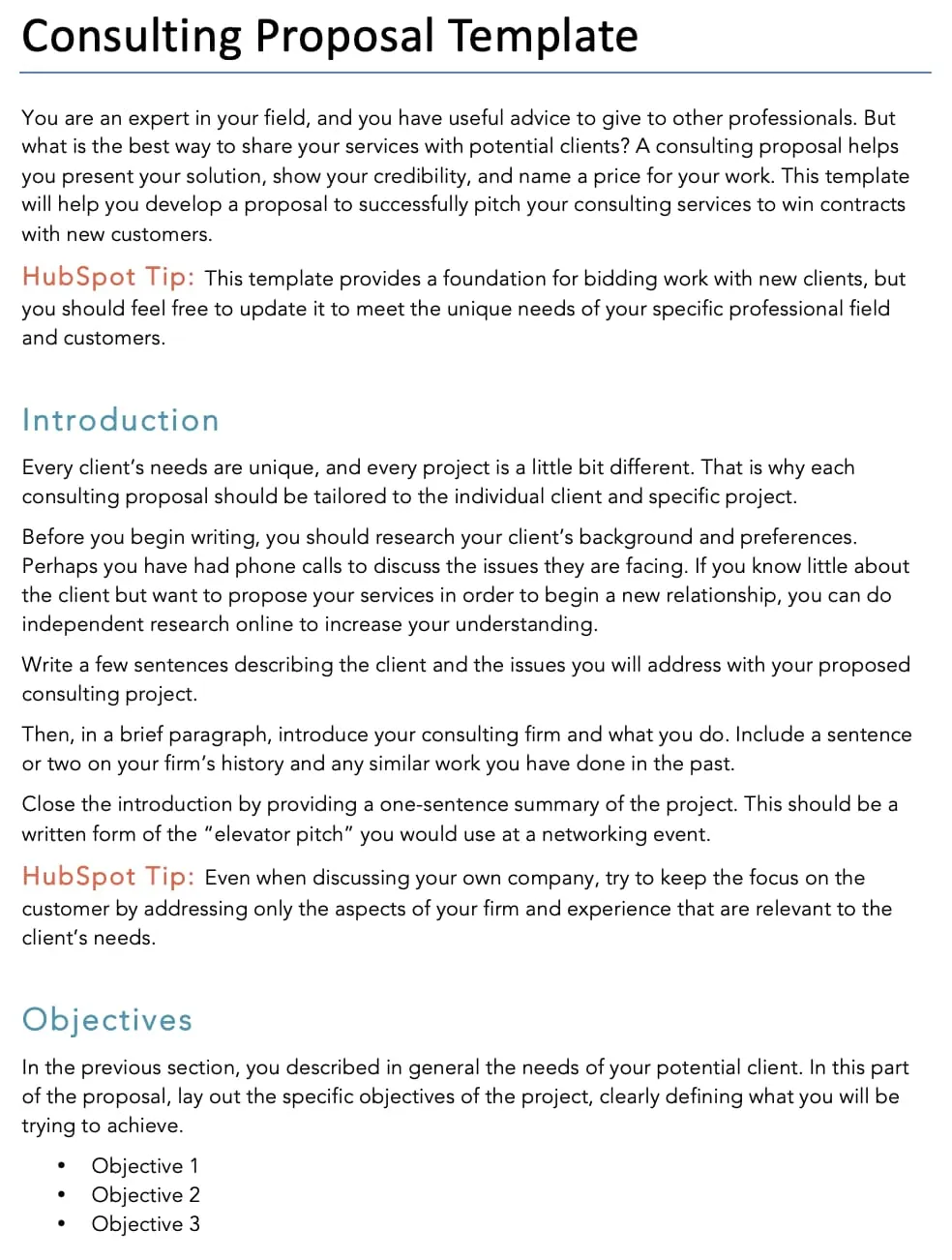
Download the Template for Free
This proposal template includes the following sections:
- Introduction. Describe the nature of the project and introduce yourself and what you do.
- Objectives. List out the goals for the project.
- Approach. Summarize your methodology for achieving the desired results and list the specific tasks you’ll undertake.
- Schedule of Project Activities. The equivalent of a “Timeline” section, you’ll use this space to describe when project tasks will be completed.
- The Team. List out any additional team members, as well as their qualifications.
- Your Investment. Lay out in clear terms what the client will be paying for.
- Signatures. Seal the deal by inviting the client to sign right away.
- Appendices. If you have specific terms and conditions for your services, include them here.
Consulting Proposal Template for Marketing
Proposals are especially critical in marketing. With so many areas of specialization, channels, deliverable types, and metrics to keep up with, you'll need to set expectations for the relationship between you and the client.
A consulting proposal for marketing might include an outline of your strategic framework, the overall goals, and perhaps even the smaller milestones you want to be measured by. This free marketing proposal template is a great place to start.
Featured Resource: Free Marketing Consulting Proposal Template

Download the Template for Free
This proposal template includes the following sections:
- Our Company and Team. In this section, you’ll give a thorough overview of your business by providing a list of your services and proposed team for the project.
- Project Scope. Summarize the project in its entirety. You’ll write a short summary, a proposed solution, and a description of projected outcomes.
- Project Schedule. List out the different stages of the project with their start and completion dates.
- Your Investment. Outline what the client will be paying for in an itemized table.
- Contact Us. Give the client an opportunity to contact you by listing your information here.
- Contract and Signatures. Streamline the process by inviting the client to sign right away.
- Additional Materials. If you want to include case studies, portfolio items, or testimonials, include them here.
How to Write a Consulting Proposal
Feeling stuck? Let’s take a look at a sample consulting proposal. To adapt this sample for your own use, I recommend replacing the mentions of the specific project with what you’ll actually be doing for your client.
Tamara Akingbola
Hotel One
123 Hotel Street, Office #123
City, State 12345
December 1, 20XX
Your Name
Consultancy Name
123 Consulting Street, Office #123
City, State 12345
Consulting Proposal
Dear Mrs. Akingbola,
It’s a pleasure to work with you on the website marketing project we discussed over the phone. I look forward to growing your website’s organic traffic at a sustained scale, helping you boost bookings and reservations, and improving the bottom line at your hotel.
In this proposal, I’ll go over a brief project summary, cover the project’s scope, share deliverables, outline a timeline, and give more details about your investment. I’ll also provide some quick next steps.
Summary
The purpose of this project is to grow organic traffic for Hotel One’s website. Due to increasing competition, older content marketing practices, and reports of a clunky user experience, the business has suffered from a marked decrease in organic traffic, which has reduced reservations and, therefore, revenue.
My digital marketing consulting firm specializes in cases just like yours. I have more than ten years of experience driving results for small businesses in the hospitality industry. My last client, Hotel Two, saw a 233% increase in bookings YoY after I worked with them.
Project Scope
To grow organic traffic and achieve sustained growth, I will be undertaking the following tasks.
- Complete a comprehensive content and technical audit of the entire website.
- Carry out usability tests on a user testing platform to check what’s currently working and what’s not.
- Consult with you as I create a new and improved content strategy.
- Hire two freelance writers to rewrite the entire website.
- Bring in the expertise of a web developer to design a modern and search-engine-optimized website.
Objectives
The objectives of the project are as follows.
- Publish relevant, keyword-optimized content that drives more users to the reservation page.
- Improve the UX of the site both in the front- and back-end.
- Increase the average ranking for target keywords by at least 2 spots.
- Get on the first page of Google SERPs for at least 20% of the target keywords.
- Redesign the entire website so that it exceeds current design and usability standards.
Deliverables
You’ll receive five deliverables from me.
- A PDF document with my findings from the content and technical audit.
- A presentation with findings from the usability tests and suggested improvements.
- A new content plan that will be approved by you prior to execution.
- An editable copy of both the rewritten and newly-written website pages.
- An entirely redesigned website with the new content and technical improvements in place.
Timeline
The estimated completion time for the entire project is six months.
|
Activity |
Start Date |
Completion Date |
|
Content Audit |
January 1 |
January 14 |
|
Technical Audit |
January 15 |
January 31 |
|
Usability Tests |
February 1 |
February 7 |
|
Content Plan Creation |
February 8 |
February 28 |
|
Content Plan Review and Approval |
March 1 |
March 7 |
|
Content Creation |
March 8 |
April 30 |
|
Website Redesign |
April 1 |
June 1 |
Investment
I charge fees per project based on the estimated time to completion.
You won’t have to worry about hiring freelance writers or finding a web developer. As your consultant, I’ll take care of that for you. All fees are inclusive of phone calls and emails.
|
Project Activity |
Hours |
Fee |
|
Content and Technical Audit |
30 |
$900 |
|
Usability Tests |
N/A |
$200 |
|
Content Plan Creation |
30 |
$900 |
|
Content Creation |
100 |
$3,000 |
|
Website Redesign |
100 |
$3,000 |
|
Total |
$8,000 |
Signature
Please sign below.
[signature form]
Next Steps
Please return the signed document to me by Wednesday, December 6. I’ll touch base with you on Friday, December 8, to discuss this proposal. You can send me any questions and concerns at email@provider.com. I look forward to working with you.
Now that you have an idea of what a sample consulting proposal looks like, I’m going to share some tools that can help with your next draft.
Consulting Proposal Example
For more inspiration on how to write your proposal, I’d like to show you an example of an audio marketing company’s proposal.
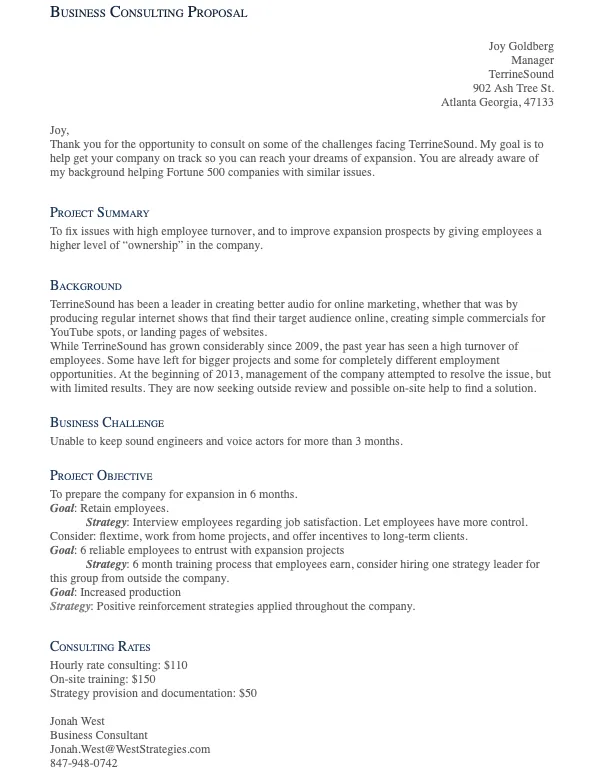
This proposal is only two pages long, but it covers a lot of ground despite its brevity. For starters, it’s got a pleasant greeting and introduction expressing thanks for the client’s consideration followed by a one-sentence project summary.
Adding a background section describing the client’s pain points in more detail is also a nice touch. The real star of this proposal, though, is the project objective section (project scope).
Instead of creating a separate section for objectives and deliverables, they are combined together. Each goal or deliverable is its own bullet point. Underneath each of these goals is the strategy that will be implemented to achieve each goal.
The next section clearly explains the vendor’s rate and fees, with a signature wrapping things up at the end.
While this proposal lacks a thorough timeline, I think it’s an excellent starting point for smaller projects.
Consulting Proposal Tools
1. DocuSign
This software has many features that can aid in consulting proposal creation. DocuSign allows you to create reusable templates and store electronic signatures in its cloud for paperless operations.
What I Like: In addition to being a robust, top-of-the-line tool, DocuSign’s security features fulfill the criteria of multiple regulatory bodies.
Pricing: While available for a free trial, prices begin from $15 per month or $120 for an annual plan. This increases depending on the feature set, number of users, and scale of your company.
2. Fiverr Workspace
You can save time drafting with the Fiverr Workspace platform. Made to create customized proposals and contracts — with free templates to work with.
What I Like: You can track the progress of a document’s creation all the way to collecting deposits at signing.
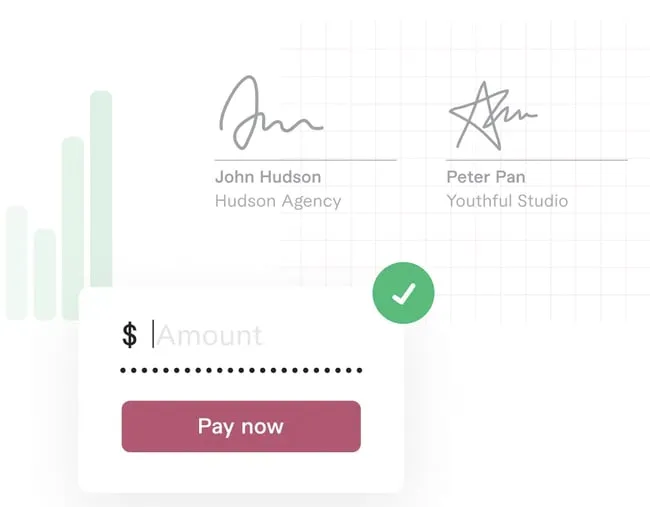
Pricing: Fiverr is free for a single client. Otherwise, its Unlimited plan is $24 a month (or a discounted rate of $18 per month if you pay yearly) for multiple accounts, which also gives you more control when editing templates.
3. Prospero
A tool dedicated solely to proposals, Prospero comes with 105+ customizable templates, document tracking details, and e-signature facilities.
What I Like: Fast and easy to set up, and also has great tracking features. The price is affordable for independent consultants. Bonus points for all their integrations.
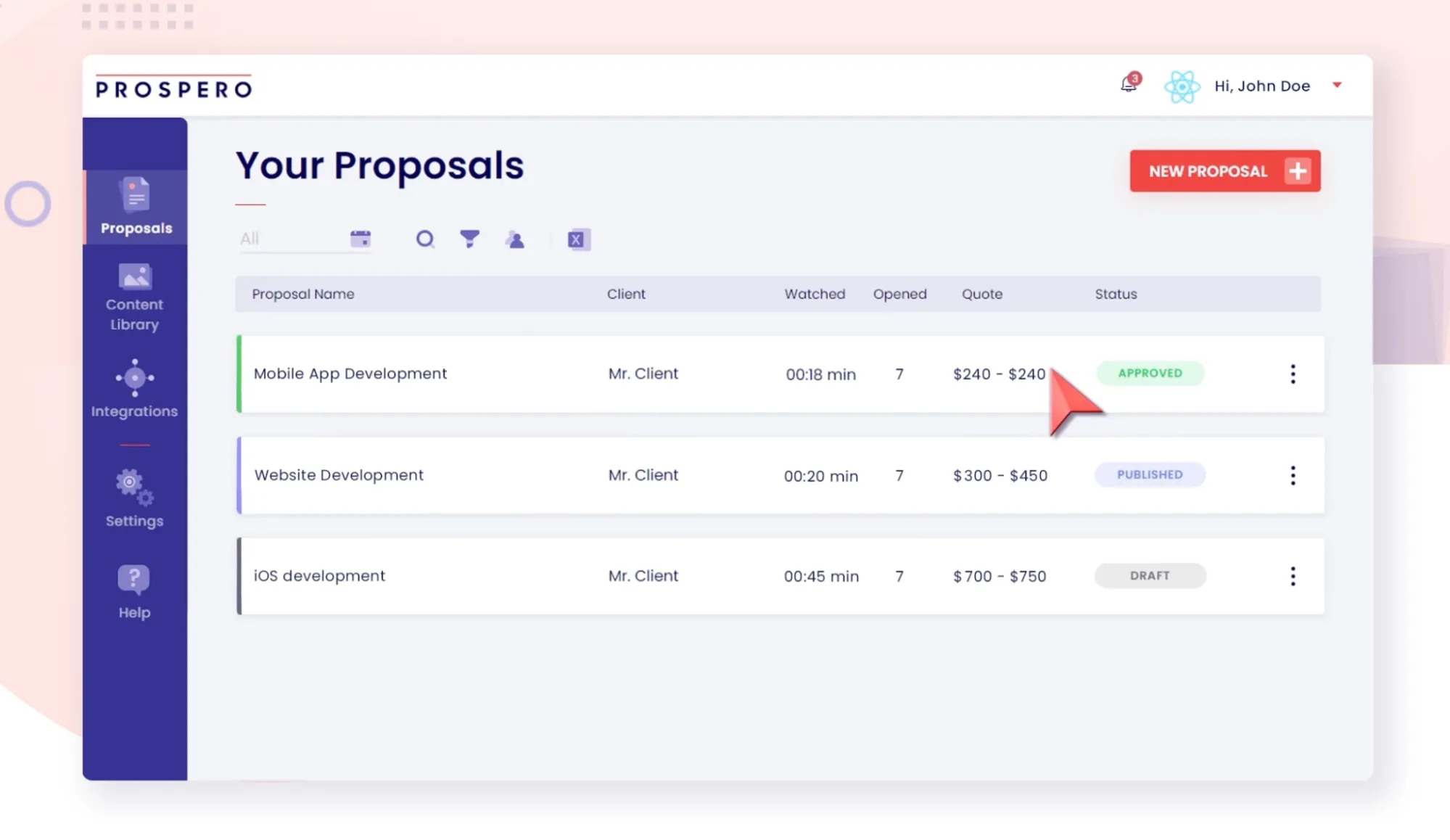
Pricing: Prospero comes with a free 14-day trial. Fees start from $10 per month (or $8 monthly when you choose the annual option), with one user and unlimited proposals. This goes up based on the number of team members.
4. Better Proposals
Better Proposals lives up to its name with the availability of 70+ beautiful proposal templates — and 260+ document templates in total — made for both desktop and mobile devices.
What I Like: With integrated signature and payment options, this platform is a useful tool for those looking to impress new clients. Bonus points for their in-product editor.
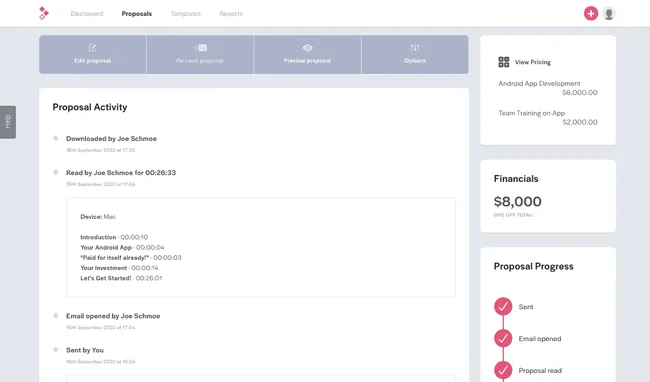
Pricing: After a 14-day free trial, you can start using the software for $19 per month, or more depending on the scale of business conducted.
Create a Consulting Proposal to Win More Clients
A well-written consulting proposal not only serves as a guidepost for a consultant-client relationship, but it can help convert prospects into loyal, long-term clients.
Implement the consulting proposal best practices I’ve shared in this post, and start developing winning proposals for your consulting business.
Editor's note: This post was originally published in December 2019 and has been updated for comprehensiveness.


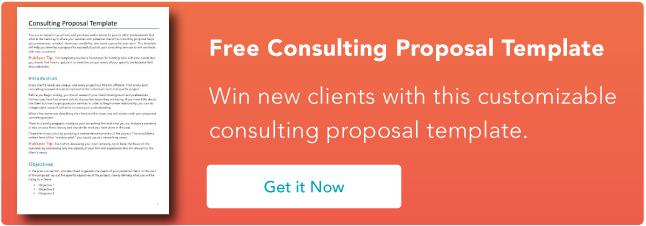

![Start a Consulting Business in 6 Steps [+Ideas for Your Venture]](https://blog.hubspot.com/hubfs/image1-Apr-06-2023-09-15-56-0028-PM.png)





![15+ Interview Questions for Consultants [+ Sample Responses]](https://blog.hubspot.com/hubfs/Consultant%20Interview.png)

